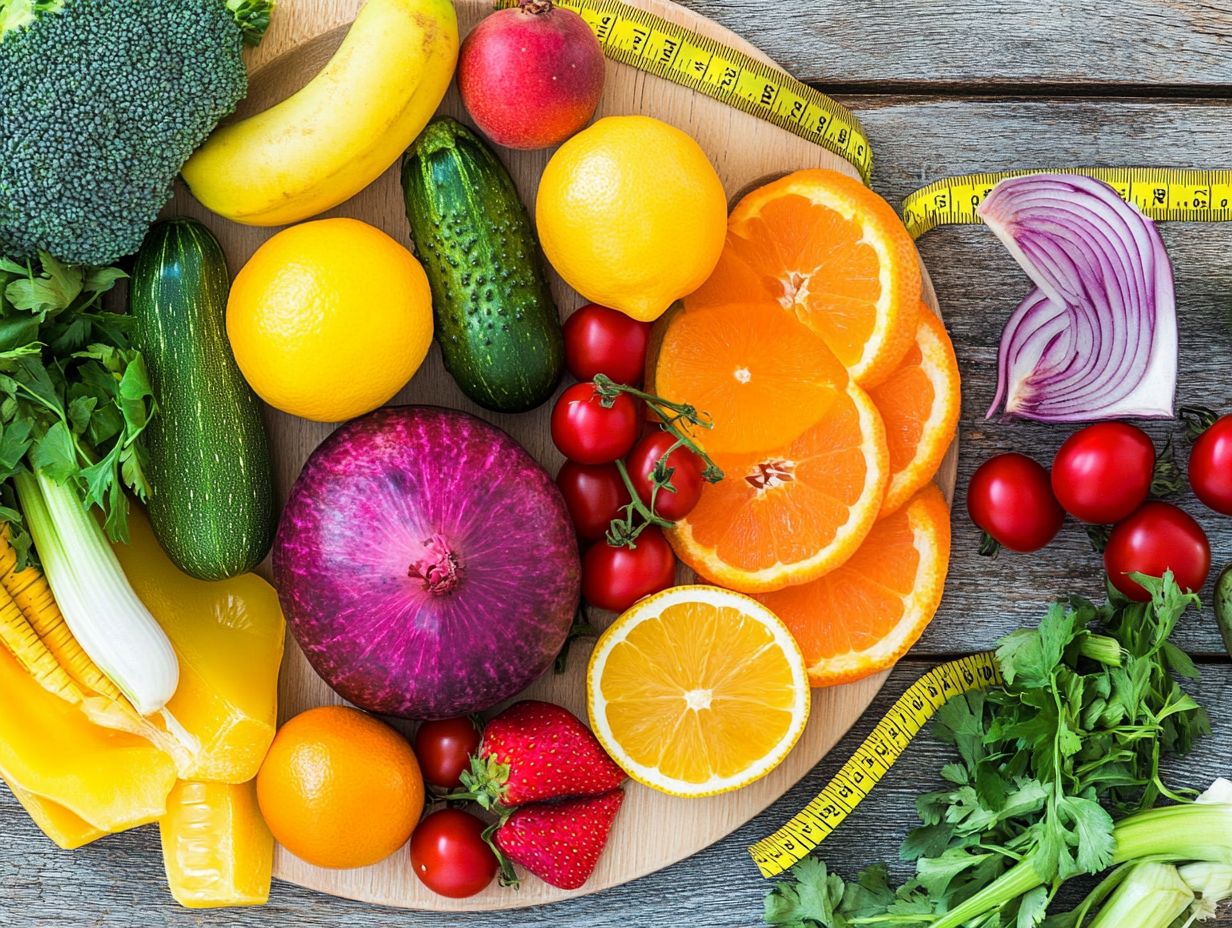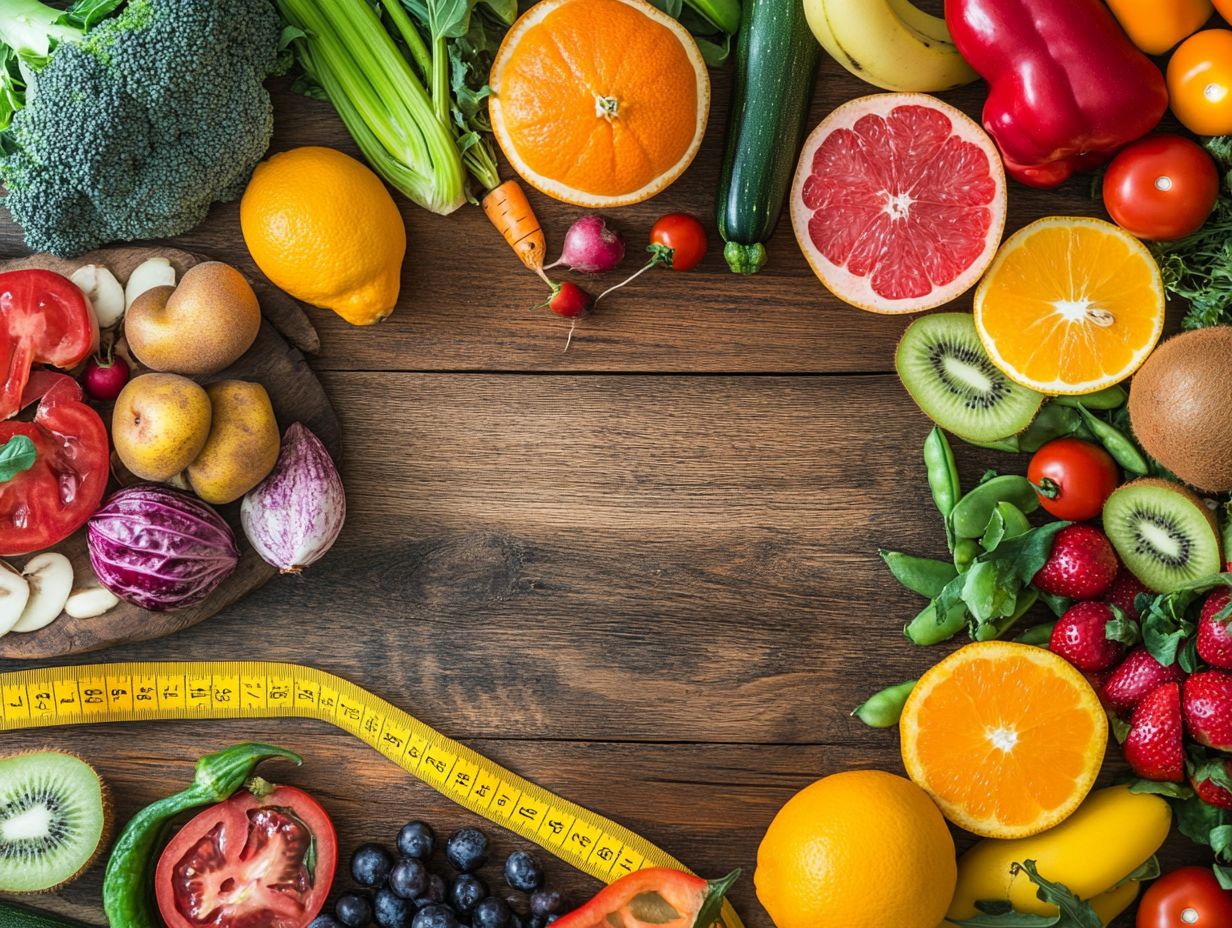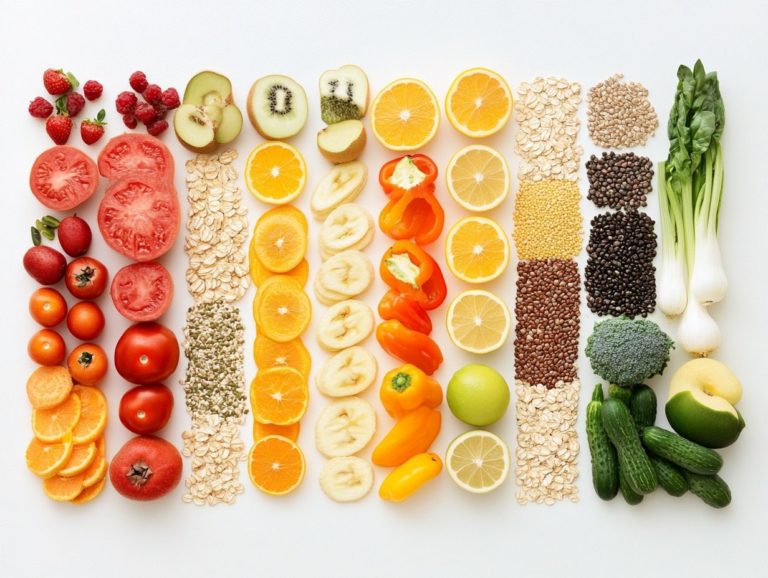6 Nutritional Guidelines for a Healthier Lifestyle
In today s fast-paced world, maintaining a balanced diet can feel overwhelming. However, it doesn t have to be complicated.
This article presents six essential nutritional guidelines to help you cultivate a healthier lifestyle. You ll discover practical tips for embracing a variety of foods, choosing whole grains, and understanding the importance of hydration.
Whether you aim to reduce processed foods or increase your intake of fruits and vegetables, these insights will serve as your roadmap to better health.
Contents
- Key Takeaways:
- 1. Eat a Variety of Foods
- 2. Limit Processed and High-Fat Foods
- 3. Incorporate More Fruits and Vegetables
- 4. Choose Whole Grains over Refined Grains
- 5. Watch Your Portion Sizes
- 6. Stay Hydrated with Water
- What Is a Balanced Diet and Why Is It Important?
- How Can One Incorporate More Variety into Their Diet?
- What Are Some Healthy Alternatives to Processed and High-Fat Foods?
- How Can One Increase Their Intake of Fruits and Vegetables?
- What Are Some Examples of Whole Grains and How Can They Be Incorporated into Meals?
- What Are Some Tips for Controlling Portion Sizes?
- How Much Water Should One Drink in a Day for Optimal Health?
- Frequently Asked Questions
- What are the 6 nutritional guidelines for a healthier lifestyle?
- How can I incorporate more fruits and vegetables into my diet?
- Why is it important to choose whole grains?
- What are some lean protein options?
- What are some examples of processed and high-fat foods to limit?
- How much water should I be drinking per day?
Key Takeaways:

- A balanced diet is important for overall health and should include a variety of foods.
- Limit processed and high-fat foods and choose healthier alternatives.
- Increase your intake of fruits and vegetables for essential vitamins and nutrients.
1. Eat a Variety of Foods
Eating a variety of foods is essential for maintaining a healthy diet and achieving good nutrition. This diversity helps provide the vitamins and minerals necessary for your overall well-being and energy management.
A balanced diet that includes starchy carbohydrates, legumes, fruits, vegetables, low-fat dairy, and protein sources like oily fish can help prevent chronic diseases such as heart disease and diabetes. It also promotes a healthy weight through portion control and lifestyle adjustments.
Incorporating these diverse food groups fuels your body and supports immune function and mental health, both vital components of overall wellness.
The World Health Organization (WHO) and the National Health Service (NHS) recommend a colorful plate, emphasizing that diversity leads to well-rounded nutrition. Each category provides unique benefits: fruits and vegetables are rich in antioxidants, while legumes offer protein without saturated fats.
By following these guidelines, you can boost your energy levels and enhance your daily performance, improving both physical health and emotional resilience.
2. Limit Processed and High-Fat Foods
Limiting processed and high-fat foods is crucial for maintaining a healthy weight and reducing the risk of chronic conditions like heart disease and obesity, worsened by excessive saturated fat and sugar intake.
Incorporating whole, nutrient-dense foods into your meals can significantly enhance your health. Instead of sugary cereals or snack bars, switch to oatmeal topped with fresh fruits or a handful of nuts. This choice packs in essential vitamins and fiber while leaving you feeling full and satisfied!
Swap sugary sodas for water infused with citrus or herbal teas. This not only aids hydration but also helps you cut down on empty calories.
These thoughtful substitutions assist in managing your weight and contribute to heart health by lowering cholesterol levels and improving metabolism. By embracing these healthier alternatives, you support a more balanced diet and foster long-term wellness.
3. Incorporate More Fruits and Vegetables
Incorporating more fruits and vegetables into your diet is essential for boosting your intake of vital vitamins and minerals, including potassium, which helps regulate blood pressure.
These nutrient-dense foods are rich in antioxidants, dietary fiber, and plant nutrients that support your immune system and promote digestive health. Opt for colorful options like berries, leafy greens, and cruciferous vegetables to ensure a diverse array of beneficial compounds.
To increase your intake, whip up smoothies packed with spinach and bananas for breakfast, or create vibrant salads with tomatoes, cucumbers, and bell peppers for lunch. Adding these ingredients as side dishes or snacks makes it easy to incorporate more healthful foods into your daily meals.
4. Choose Whole Grains over Refined Grains
Choosing whole grains over refined grains is a pivotal element of a balanced diet. Whole grains also offer a wealth of fiber, vitamins, and minerals that support healthy energy consumption and assist in weight management.
This choice is crucial, not just for immediate health benefits but also for long-term wellness. Think about whole grains like quinoa, brown rice, and barley; they keep all parts of the grain, making them nutrient-dense options rich in antioxidants and other beneficial compounds. In contrast, refined grains are processed in a way that strips away these essential parts, leading to a significant loss of fiber and vital nutrients.
To effortlessly elevate your meals, consider swapping white rice for farro in your salads or opting for whole-grain pasta instead of conventional varieties. Oatmeal can serve as a delightful breakfast, easily enhanced with fruits and nuts for an extra burst of flavor and nutrition.
5. Watch Your Portion Sizes

Practicing portion control is essential for maintaining a healthy weight and achieving effective weight loss. By understanding serving sizes, you can manage your energy consumption and prevent overeating, crucial for reaching your desired Body Mass Index (BMI).
Simple techniques, like using smaller plates or measuring cups, help you better estimate your food intake without feeling deprived. When you take the time to read nutrition labels, you gain a more informed perspective on meal planning, ensuring that your meals are both balanced and satisfying.
Creating a mindful eating environment such as eliminating distractions during meals can significantly enhance your awareness of portion sizes. These deliberate actions not only aid in weight management but also support your overall nutritional balance, paving the way for a healthier lifestyle that aligns with your personal goals.
6. Stay Hydrated with Water
Staying hydrated with an adequate intake of water is crucial for maintaining your energy levels, supporting bodily functions, and promoting a healthy weight. Dehydration can significantly hinder your physical activity and overall nutritional status.
Proper hydration is more than just a remedy for thirst; it s a vital aspect of your overall health and wellness. It aids your body in regulating temperature, maintaining joint lubrication, and facilitating nutrient transport.
For adults, the general recommendation is to drink about 2 to 3 liters roughly 8 to 12 cups of water daily, depending on individual factors like your activity level and climate.
To boost your water intake, consider these strategies:
- Carry a reusable water bottle with you throughout the day.
- Infuse your water with fruits or herbs to add a refreshing twist.
- Incorporate hydrating foods like cucumbers and watermelon into your meals.
What Is a Balanced Diet and Why Is It Important?
A balanced diet comprises a variety of foods in the right proportions, delivering essential nutrients crucial for your health and optimal nutritional status. This balance plays a vital role in preventing diseases like heart disease and diabetes, as highlighted by dietary guidelines from organizations such as the WHO and NHS.
Your diet should include carbohydrates to fuel your energy needs, proteins to aid in muscle repair and growth, and healthy fats to support brain function. Don t forget the importance of vitamins and minerals they’re key to overall bodily functions. Each component works together harmoniously, promoting not just physical health but also mental well-being.
When you prioritize this balance, you often find yourself enjoying improved energy levels, enhanced immune responses, and a reduced risk of chronic illnesses.
Recognizing the significance of incorporating diverse food sources helps you cultivate healthier eating habits that can last a lifetime. This commitment ultimately contributes to your long-term health and happiness.
Start today and make small changes for a healthier you!
How Can One Incorporate More Variety into Their Diet?
Adding variety to your diet boosts your nutritional status. Include different food groups like legumes, dairy, and plant-based options to give your body essential vitamins and minerals.
Trying out new recipes is an exciting adventure. It lets you enjoy vibrant flavors and textures while improving your nutrition.
For instance, Mediterranean dishes are celebrated for their heart-healthy fats and abundant fiber from legumes. Asian recipes frequently emphasize fresh produce and diverse grains. By swapping out familiar staples for ingredients from various culinary traditions, you can enjoy meals that taste great and keep you healthy.
What Are Some Healthy Alternatives to Processed and High-Fat Foods?
Finding healthy alternatives to processed and high-fat foods is crucial for maintaining a balanced diet and lowering your risk of heart disease. Consider swapping out snacks high in saturated fat for nutrient-rich options like fruits, vegetables, and whole grains.
For example, think about replacing traditional potato chips with air-popped popcorn or baked kale chips. Both offer that satisfying crunch while packing in fiber and vitamins.
Using Greek yogurt instead of sour cream is another smart move; it adds protein and cuts down on fat, making it a versatile ingredient for dips and dressings.
Incorporating lentils or beans instead of ground beef in your chili or tacos can significantly lower saturated fat while boosting your protein and fiber intake. By being mindful of these simple substitutions in your everyday meals, you can relish delicious flavors without compromising your health.
How Can One Increase Their Intake of Fruits and Vegetables?

Increasing your intake of fruits and vegetables is an excellent strategy for enhancing your essential vitamins and minerals. It ultimately leads to better overall health and a reduced risk of obesity and heart disease.
Incorporating a diverse array of these nutrient-rich foods can be both simple and enjoyable with just a few actionable steps. For example, dedicate some time each week to meal prep: chop up fresh vegetables and portion them into convenient snacks or add them to your meals.
Having healthy options readily available makes it easier to choose wholesome snacks, whether it s crunchy baby carrots with hummus or a crisp apple for an energizing boost.
Mixing different colored fruits and vegetables keeps your meals vibrant and exciting while maximizing the range of nutrients you re consuming. By experimenting with new flavors and textures in your cooking, you ll find yourself more inclined to incorporate these wholesome ingredients into your daily routine.
What Are Some Examples of Whole Grains and How Can They Be Incorporated into Meals?
Whole grains, such as brown rice, quinoa, and whole wheat bread, can effortlessly elevate your balanced diet. They enhance energy consumption and nutritional intake while offering healthier alternatives to refined grains.
These grains are carriers of essential nutrients like fiber, vitamins, and minerals. They also help maintain sustained energy levels throughout your day.
For instance, brown rice is a powerhouse of manganese and selenium, supporting both metabolic processes and your immune system. Quinoa, a grain packed with protein, contains all nine essential amino acids, making it an ideal choice for vegetarian meals.
Whole wheat bread serves as a robust foundation for sandwiches, especially when loaded with fresh vegetables and lean proteins.
By incorporating quinoa into your salads or pairing brown rice with stir-fried vegetables, you can seamlessly enhance the nutritional value of your breakfasts, lunches, and dinners.
What Are Some Tips for Controlling Portion Sizes?
Controlling portion sizes is essential for achieving and maintaining a healthy weight and optimal Body Mass Index (BMI). You can effectively manage this through various strategies. For instance, using smaller plates can help, as can measuring your food before serving.
Incorporating visual aids can simplify this process. You might use the size of your fist or palm to gauge appropriate servings. Comparing serving sizes to everyday items like a baseball for fruit or a deck of cards for meat provides tangible references that reinforce portion control.
Embracing mindful eating practices can significantly enhance your portion management. Savor each bite and tune into your hunger cues. By focusing on the experience of eating and being present in the moment, you can make more informed choices about how much food you genuinely need.
How Much Water Should One Drink in a Day for Optimal Health?
The optimal daily water intake for your health typically falls between 2 to 3 liters. This varies based on your individual needs, activity level, and climate. Hydration is crucial for your energy and overall well-being.
Factors like age, gender, and general health also significantly influence the precise amount of water that s right for you. For example, if you re an athlete or someone who engages in intense physical activities, you ll likely need to drink more fluids to compensate for what you lose through sweat.
Hot and humid weather can further escalate your hydration needs. To help you stay well-hydrated throughout the day, consider these practical tips:
- Always carry a reusable water bottle.
- Snack on hydrating foods like fruits and vegetables.
- Set reminders to drink water regularly.
By seamlessly integrating hydration into your daily routine, you can effectively meet your fluid needs and enhance your overall health.
Frequently Asked Questions
What are the 6 nutritional guidelines for a healthier lifestyle?

The 6 nutritional guidelines for a healthier lifestyle are: eating a variety of fruits and vegetables, choosing whole grains, consuming lean proteins, limiting processed and high-fat foods, reducing added sugars and sodium, and staying hydrated with water.
How can I incorporate more fruits and vegetables into my diet?
You can easily incorporate more fruits and vegetables into your diet by including them in every meal, choosing them as snacks, and trying new varieties to keep things interesting.
Why is it important to choose whole grains?
Choosing whole grains provides your body with essential nutrients like fiber, vitamins, and minerals. They help you feel full and satisfied, making it easier to maintain a healthy weight.
What are some lean protein options?
Some lean protein options include skinless chicken or turkey, fish, tofu, beans, and lentils. It’s important to vary your protein sources to ensure you’re getting a range of nutrients.
What are some examples of processed and high-fat foods to limit?
Processed and high-fat foods to limit include sugary drinks and snacks, fried foods, processed meats, and baked goods made with refined flour and sugar.
How much water should I be drinking per day?
The general recommendation is to drink 8-10 cups (64-80 ounces) of water per day. However, this may vary based on your individual needs and activity level. Listen to your body and drink water when you feel thirsty.






